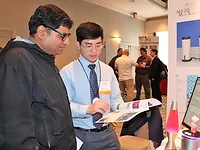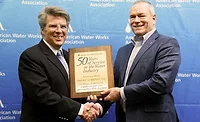The Last 50 Years
In the middle of the 20th century, the mass production of consumer and luxury goods, including durable goods with a large number of units per production run, became increasingly important. The need increased for protecting such goods against corrosion, weathering effects and for increased environmental safety. Coatings of all conceivable categories were called upon to meet these requirements as much as possible. In general, multilayer films from one to several millimeters were needed. The application necessitated processing equipment and increased the overall cost substantially. The coating was usually diluted with organic solvent and was mostly applied on the substrate through normal dipping, casting, spraying or brushing. These organic solvents or thinners were low-volatile, low-flashing and, in many cases, hazardous to health.
Major progress was made at the end of the 1950s in Europe, North America and Japan through intensive chemical and process development in the resin/paint field. This paved the way for subsequent research so that in the decades following the mid 1960s great product improvement was made that met essentially every aspect of the performance need. However, more strenuous efforts in basic research leading to the development of market/customer-oriented products and processes were still necessary. The proper protection of intellectual property rights in the industrial nations was always important, indispensable at that time and provided a suitable environment for this development.
The knowledge, results and R&D products accumulated in the first half of the 20th century made it possible for the successful effort in the following decades towards discovering suitable and mass-producible products and the necessary processing technologies that fulfilled virtually all key requirements of the coating systems for the future.
All of the referred innovations, and thus derived coating products, shared the same characteristics. They must essentially be less flammable, less hazardous to health and less harmful to the environment. Of course these products should display improved overall properties despite being applied in thinner layers on natural and also on metallic/non-metallic substrates.
The advancement in chemistry of coal, petroleum and ultimately synthetic resins in the first half of the last century brought about the best prerequisite and solid foundation for further development. The research in physical, electro-technical and process technology also contributed in propelling such advancement. It should be no surprise that new future-oriented development and innovation in the field of surface coatings and substrates took place since it was already pre-programmed!
In principle, four significant and basic systems have crystallized out of the R&D endeavor:
- water-reducible systems;
- high-solids systems;
- radiation-curing systems; and
- powder systems.
- dipping/casting;
- brushing/coil;
- electrostatic/airless spraying;
- milling;
- stamping; and
- printing.

Water-Reducible Systems
In the dipping application there are two processes that achieved a dominant position during the past 40 years. The so-called Elektrotauch-Applikationen (“ETL” or “EC”) proved to be very efficient for all cases of industrial coatings on metallic substrates (Fe/Al/Mg/Cu) and their alloys. The anodic ETL (ATL) process dominated the market almost without exception at the outset during the period from the mid 1960s until 1980/81. However, in the following decades through today, cathodic ETL (KTL) has taken the lead and will be the process of choice in the future due to its superior efficiency and quality. In both processing technologies it has been basically proven that properly adjusted electrical voltages in a water medium, as listed below, are critical:- ATL… 100 to 300 volt at 10 to 15% NV at 20 to 25 °C;
- KTL… 200 to 500 volt at 15 to 20% NV at 23 to 28 °C.
For water-reducible binder/paint systems with very high water content under working conditions (80 – 95% parts of water in the volatile components) all resin and polymer used must be fundamentally at least water-reducible.
Even though the principles in rendering resins and polymers water soluble or reducible have been known for some time, it was nevertheless necessary to dedicate a large amount of R&D effort in this field for a period of 30 to 50 years after 1950. The knowledge gained in the research of water-colloid, water-emulsion and water-suspension also contributed some valuable and useful results to this effort.
In all cases, resin and polymer with hydrophilic, polar, functional groups such as –OH, -COOH and -NR2 are mandatory. In addition, the acid or alkaline group should always be partially neutralized in order to transfer the water-reducible property to resin/polymer systems.
Water reducibility can be influenced by the content of one or more additional hydrophilic and polar solvent. It can also be influenced by the viscosity/solids relationship during the thinning stage with water (Figure 1).
For electrocoating, where film buildup plays a major role, it is important to track the time/current/resistance relationship (Figure 2).
Depending on the system (ATL or KTL), the corresponding pH/conductivity values during the process can be of considerable influence.

High-Solids Systems
In the development of high-solids systems, including the subsequent film-formation process for coating and color, it is by all means not only critical to avoid the “lifting” of the solids from the paint and ink, but the solvents or thinners used should also be non-hazardous to health. The latter requirement applies to pigments, fillers and any additives used, as they should not have carcinogenic effects on human or animal life.
The temperature of the conventional and electrostatic application of these
high-solids systems including waterborne paint lies between 30 °C and 200 °C under all hardening or
film-forming conditions.
Radiation-Curing Systems
In the second half of the 20th century unsaturated polyester (UP) with a reactive thinner, e.g., styrene, has, without any exception, ruled the “radical” or “radiation-curable” coating market and the fiber-binding sector. The polymerization or crosslinking/hardening of the UP system was initially made feasible by the use of catalysts. Later on, due to the strong growth, broadened end-use application and modernized processing techniques for UP systems, the use of special sources of UV as the “hardener” became a reality.The constantly increasing demand imposed on clear, filled, pigmented and fiber-reinforced intermediate or finished goods and coatings with corrosion and chemical resistance as well as mechanical stability provided opportunity for the further development of radiation-crosslinkable or polymerization systems. For example, vinyl ester, a low-molecular-weight polymer (oligomer), in combination with reactive diluent(s) became the latest significant raw material in the field of highly value-added and performance-demanding applications. It plays a unique role among other end uses also in the coating application along with unsaturated polyesters.
It is well known that among coating end-use applications the clear or pigmented radiation-curable systems have been used mostly as one coat/top coat for all conceivable plastics, wood, cork, paper/paper board, ceramic and metal applications. Similar systems have also found application in adhesive and self-adhering, or so-called, “Antihaft” coatings. This fact demonstrates another high value-added basic feature of UV systems. In addition, their broad application in the printing ink sector should not be left without being mentioned.
The following processing conditions for the film forming or crosslinking of the coating should be noted:
- For vinyl ester, with acrylate-based reactive diluent, 2 to 5 minutes at 30 ±10 °C under nitrogen;
- For UP, with styrene as reactive diluent, 5 to 10 minutes at 30 ±10 °C under normal atmosphere.
Powder Systems
During the second half of the 20th century, powder coating systems were developed and practiced successfully in large-scale finishing processes. An unequivocal and indisputable environmental friendly coating technology was brought to realization. Almost all of the powder coatings have been applied on corresponding substrates using electrostatic method.Depending on the specific performance profile of the coating in question, thermoplastic material and its modifications, as well as crosslinkable thermosets such as saturated epoxy, saturated polyester, saturated acrylate and any possible combination systems thereof, can be utilized.
The processing conditions for the melting/film-forming stage and the eventual crosslinking or polymerization via addition reaction are:
- 10 to 30 minutes at 120 ± 10 °C for thermoplastics;
- 10 to 30 minutes at 150 to 200°C for thermosets.
- Laboratory Exploration k Pilot Trial k Industrial
Practice.
Lastly, the emergence of nano technology in the 1980s and 1990s should be noted. Such technology has proven to be applicable in high-technology systems using resin, polymer and coating/paint.
Conclusion
In summary, from the middle of the 20th century until today, the industry involving overall ground and top surface finishing sector and its corresponding matching coatings with paint, color and printing ink has lived through progressions of a gigantic scale. Further development leading to products with superior performance, better compliance to government regulation and increased environmental friendliness is certainly expected to evolve during the remainder of the 21st century.Looking for a reprint of this article?
From high-res PDFs to custom plaques, order your copy today!






